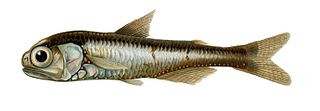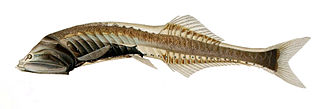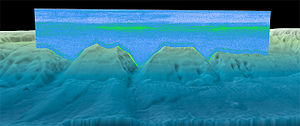
Deep-sea fish are fish that live in the darkness below the sunlit surface waters, that is below the epipelagic or photic zone of the sea. The lanternfish is, by far, the most common deep-sea fish. Other deep-sea fishes include the flashlight fish, cookiecutter shark, bristlemouths, anglerfish, viperfish, and some species of eelpout.
The aphotic zone is the portion of a lake or ocean where there is little or no sunlight. It is formally defined as the depths beyond which less than 1 percent of sunlight penetrates. Above the aphotic zone is the photic zone, which consists of the euphotic zone and the disphotic zone. The euphotic zone is the layer of water in which there is enough light for net photosynthesis to occur. The disphotic zone, also known as the twilight zone, is the layer of water with enough light for predators to see but not enough for the rate of photosynthesis to be greater than the rate of respiration.

The swim bladder, gas bladder, fish maw, or air bladder is an internal gas-filled organ that contributes to the ability of many bony fish to control their buoyancy, and thus to stay at their current water depth without having to expend energy in swimming. Also, the dorsal position of the swim bladder means that the expansion of the bladder moves the center of mass downwards, allowing it to act as a stabilizing agent in some species. Additionally, the swim bladder functions as a resonating chamber, to produce or receive sound.
The pelagic zone consists of the water column of the open ocean and can be further divided into regions by depth. The word pelagic is derived from Ancient Greek πέλαγος (pélagos) 'open sea'. The pelagic zone can be thought of as an imaginary cylinder or water column between the surface of the sea and the bottom. Conditions in the water column change with depth: pressure increases; temperature and light decrease; salinity, oxygen, micronutrients all change. Somewhat analogous to stratification in the Earth's atmosphere, but depending on how deep the water is, the water column can be divided vertically into up to five different layers.
The mesopelagiczone, also known as the middle pelagic or twilight zone, is the part of the pelagic zone that lies between the photic epipelagic and the aphotic bathypelagic zones. It is defined by light, and begins at the depth where only 1% of incident light reaches and ends where there is no light; the depths of this zone are between approximately 200 to 1,000 meters below the ocean surface.
The bathypelagic zone or bathyal zone is the part of the open ocean that extends from a depth of 1,000 to 4,000 m below the ocean surface. It lies between the mesopelagic above and the abyssopelagic below. The bathypelagic is also known as the midnight zone because of the lack of sunlight; this feature does not allow for photosynthesis-driven primary production, preventing growth of phytoplankton or aquatic plants. Although larger by volume than the photic zone, human knowledge of the bathypelagic zone remains limited by ability to explore the deep ocean.

The benthic zone is the ecological region at the lowest level of a body of water such as an ocean, lake, or stream, including the sediment surface and some sub-surface layers. The name comes from ancient Greek, βένθος (bénthos), meaning "the depths." Organisms living in this zone are called benthos and include microorganisms as well as larger invertebrates, such as crustaceans and polychaetes. Organisms here generally live in close relationship with the substrate and many are permanently attached to the bottom. The benthic boundary layer, which includes the bottom layer of water and the uppermost layer of sediment directly influenced by the overlying water, is an integral part of the benthic zone, as it greatly influences the biological activity that takes place there. Examples of contact soil layers include sand bottoms, rocky outcrops, coral, and bay mud.

Lanternfish are small mesopelagic fish of the large family Myctophidae. One of two families in the order Myctophiformes, the Myctophidae are represented by 246 species in 33 genera, and are found in oceans worldwide. Lanternfishes are aptly named after their conspicuous use of bioluminescence. Their sister family, the Neoscopelidae, are much fewer in number but superficially very similar; at least one neoscopelid shares the common name "lanternfish": the large-scaled lantern fish, Neoscopelus macrolepidotus.

Pelagic fish live in the pelagic zone of ocean or lake waters—being neither close to the bottom nor near the shore—in contrast with demersal fish that live on or near the bottom, and reef fish that are associated with coral reefs.

Demersal fish, also known as groundfish, live and feed on or near the bottom of seas or lakes. They occupy the sea floors and lake beds, which usually consist of mud, sand, gravel or rocks. In coastal waters they are found on or near the continental shelf, and in deep waters they are found on or near the continental slope or along the continental rise. They are not generally found in the deepest waters, such as abyssal depths or on the abyssal plain, but they can be found around seamounts and islands. The word demersal comes from the Latin demergere, which means to sink.

A viperfish is any species of marine fish in the genus Chauliodus. Viperfishes are mostly found in the mesopelagic zone and are characterized by long, needle-like teeth and hinged lower jaws. A typical viperfish grows to lengths of 30 cm (12 in). Viperfishes undergo diel vertical migration and are found all around the world in tropical and temperate oceans. Viperfishes are capable of bioluminescence and possess photophores along the ventral side of their body, likely used to camouflage them by blending in with the less than 1% of light that reaches to below 200 meters depth.

Maurolicus muelleri, commonly referred to as Mueller's pearlside,Mueller's bristle-mouth fish, or the silvery lightfish, is a marine hatchetfish in the genus Maurolicus, found in deep tropical, subtropical and temperate waters of the Pacific Ocean and the Atlantic Ocean, from the surface to depths of 1,500 metres (4,900 ft). It can grow to a maximum total length of 8 centimetres (3.1 in).

Electrona is a genus of lanternfishes in the family Myctophidae.

Warming's lantern fish, Ceratoscopelus warmingii, is a lanternfish of the family Myctophidae, found circumglobally in both hemispheres, at depths of between 700 and 1,500 m during the day and between 20 and 200 m at night. Its length is about 8 cm (3.15 in).

Diel vertical migration (DVM), also known as diurnal vertical migration, is a pattern of movement used by some organisms, such as copepods, living in the ocean and in lakes. The adjective "diel" comes from Latin: diēs, lit. 'day', and refers to a 24-hour period. The migration occurs when organisms move up to the uppermost layer of the water at night and return to the bottom of the daylight zone of the oceans or to the dense, bottom layer of lakes during the day. DVM is important to the functioning of deep-sea food webs and the biologically-driven sequestration of carbon.

A deep-sea community is any community of organisms associated by a shared habitat in the deep sea. Deep sea communities remain largely unexplored, due to the technological and logistical challenges and expense involved in visiting this remote biome. Because of the unique challenges, it was long believed that little life existed in this hostile environment. Since the 19th century however, research has demonstrated that significant biodiversity exists in the deep sea.

The oceanic zone is typically defined as the area of the ocean lying beyond the continental shelf, but operationally is often referred to as beginning where the water depths drop to below 200 metres (660 ft), seaward from the coast into the open ocean with its pelagic zone.

Cyclothone is a genus containing 13 extant species of bioluminescent fish, commonly known as 'bristlemouths' or 'bristlefishes' due to their shared characteristic of sharp, bristle-like teeth. These fishes typically grow to around 1-3 inches, though some can be larger. They are most commonly found in the mesopelagic zone of the ocean, mostly at depths of over 300 meters, and many species have bioluminescence.

Galiteuthis glacialis is a species of glass squid from the Antarctic Convergence. It is in the cranchiidae family and subfamily taoniinae. They are endemic to the Antarctic and are found in the Southern Ocean, around the Weddell Sea and the South Shetland Islands. Galiteuthis glacialis are one of the most plentiful and widely dispersed species of Antarctic squid. These squids are found in the mesopelagic and bathypelagic layers of the open ocean and demonstrate vertical migration. They can reach a maximum mantle length of 500 mm (0.5m).
A micronekton is a group of organisms of 2 to 20 cm in size which are able to swim independently of ocean currents. The word 'nekton' is derived from the Greek νήκτον, translit. nekton, meaning "to swim", and was coined by Ernst Haeckel in 1890.


















